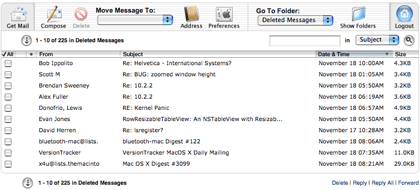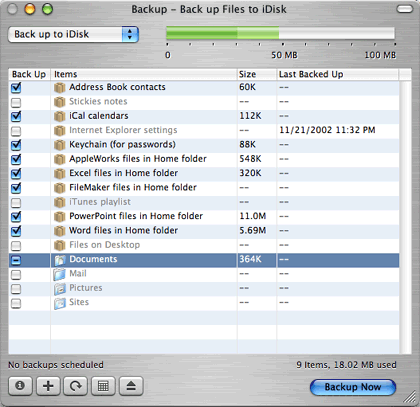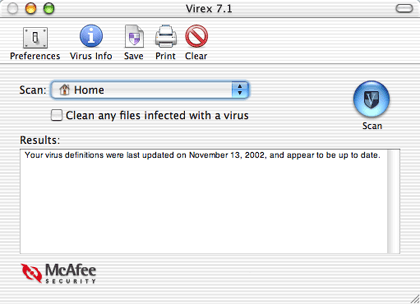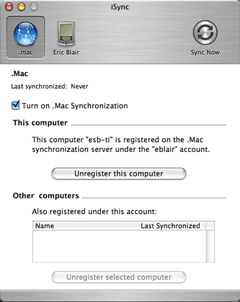Review: .Mac

Developer: Apple Computer
Price: $99.95
Requirements: Mac OS 9 or Windows 98
Recommended: Mac OS X 10.2
Trial:
Feature-limited (60-day account, limited e-mail and iDisk
storage, no anti-virus software, no backing up to removable media)
Ever since Steve Jobs announced the death of iTools and the birth of .Mac, the question on the mind of many people has been “Is .Mac worth it?” If all you are looking for are the e-mail address, Web page, and storage space from your old iTools account, then the answer is probably “No”; there are a number of less expensive solutions that will give you these features. If you still use OS 9 as your primary operating system, then you should probably look elsewhere, since many of .Mac’s features require OS X. However, if you’re interested in some of the new features Apple has added to .Mac, along with tight integration with OS X and several of the iApps, then you should read on.
Old Friends
When .Mac was first announced, many people had problems with the fact that most of the services were essentially the same things that came free with iTools—mac.com e-mail, iDisk, HomePage, iCards, and iPhoto integration. Since the release of .Mac, the .Mac e-mail and iDisk have both changed slightly while HomePage, iCards, and iPhoto integration have remained mostly the same.
There are two main features of a .Mac e-mail account. First, you get 15 MB of disk space for storing e-mail. This allows you to keep a lot of mail on the server so it can be accessed anywhere you can find Internet access. To give you an idea of how many messages you can store with 15 MB, I currently have 384 messages sitting in my account using a total of 5.1 MB of space.
Second, Apple’s interface for reading e-mail on the Web is possibly the best I’ve ever seen. If I remember correctly, it was in beta testing during the last days of iTools, but it wasn’t declared final until the announcement of .Mac. The main interface contains a toolbar similar to one you would find in many OS X applications. You can search the Subject, From, To, and CC fields of e-mails from the mail list instead of switching to a dedicated search page.
Under Webmail’s preferences, you can specify your signature, whether or not you want to include a photo, your viewing, sending, and receiving preferences, and whether you would like to check an external POP account.

Checking your e-mail on the Web.
The photo option does not use the X-Face e-mail header. Instead, if you e-mail somebody who uses the Webmail interface or Mail.app, the picture is downloaded from the .Mac server. As far as I can tell, no other e-mail application can take advantage of this feature.
I do have a pair of complaints about the Webmail interface. First, you must go to the preferences and retype your password whenever you want to check an external POP account. It would be nice if .Mac would remember the account information and let you check the account from the main interface. Second, there is no way to get your address book from the new Address Book application into .Mac or vice-versa. Considering the integration between .Mac and several of Apple’s other applications, this is extremely disappointing. Hopefully, this will either be addressed by an update to the Address Book or the final release of iSync.
The biggest change in iDisk is that the base storage size has increased from 20 MB to 100 MB. The standard iDisk includes folders named Documents, Movies, Music, Pictures, Public, Sites, Backup, and Software. The first folders mirror the folders of the same names in every user’s home folder on OS X. That said, it would be nice if they picked up the same custom icons as their Home folder counterparts. Backup is a read-only folder that is used with Apple’s Backup application. Software contains many programs placed there by Apple that you are free to download. This folder is also read-only, but it doesn’t count against your allocated storage space. If you use iSync, a folder named Library will appear that contains information about your syncing preferences.
For some reason, Apple doesn’t bother to publicize HomePage all that much. I don’t use it that much because I prefer to design my own Web sites on my own computer, but it seems to be fairly well designed. Apple provides over 50 themes to which you can add your own information. These themes are split into categories like Photo Album, iMovie, Resume, Education, File Sharing, and Site Menu.
It’s probably the least interesting of the categories, but I’m really impressed by the Site Menu templates. By default, there is an entry in the menu for every page in your site. You can delete these default entries and add entries to pages elsewhere on the Web. The only requirement is that the image you use in the menu must be in your iDisk’s Picture folder. Of course, the part I find really cool is when you’re editing your menu, you can drag-and-drop the entries to reorder them on the page, similar to creating menus in iDVD. This might seem like a no-brainer, but I love the fact that Apple was able to add this functionality to a Web site. It really helps that you can take knowledge from one Apple application and apply it in another.
I believe that iCards is the only portion of iTools that remained free for anybody to use following the release of .Mac. The only advantage to using iCards with a .Mac membership is you can create iCards using your own photos instead of being restricted to Apple’s stock designs.
iPhoto integration is the one feature I was upset about people losing in the transition from iTools to .Mac. Unlike most of the other .Mac features, iPhoto integration is accessed by a single button (under Sharing in iPhoto) in an application Apple ships with every computer. This is similar to the iDisk integration in the Finder. Unlike iDisk integration, though, nothing changed in regards to iPhoto. For some people, this button just went from working one day to not working the next. Hopefully, Apple will address this in an update to iPhoto—either hide the option for people not using iPhoto or come up with some alternative method of getting photos onto the Internet, similar to iCal’s support for WebDAV.
Backup
Apple touted Backup as one of the new features of .Mac. For basic backups, it works acceptably, but it is lacking when it comes to the more advanced features. For instance, Apple includes a number of QuickPicks for getting all of a certain type of file in a given location—for instance, all Word files in the Home folder or all iTunes playlists. However, there’s no way to specify your own QuickPicks. So, if you wanted to back up all the Quicken files in your Home directory (or even on your hard drive), you would have to locate all the files and add them by hand.
Also, backing up data to your iDisk can take up a lot of space. If you want to do something like back up several years of e-mail, you could very quickly consume all of your space. For instance, my Mailsmith mail file would fill my iDisk many times over.

Keeping your data safe on Apple’s server.
Along with working with your iDisk, Backup can also archive data to a CD or DVD recorder. This is great for keeping larger files safe. However, Backup will only record to a CD or DVD if it can verify your .Mac membership. Since it needs to go online to do this, there’s no way to back up your data when you are not connected to the Internet.
On the bright side, Backup does support limited backups sets. You can specify one group of files for backup to an iDisk and a second group for backup to removable media. This will let you keep a smaller collection of files on your iDisk so you can back them up on a regular basis using Backup’s scheduled backup option while also keeping your large files backed up when you have access to removable media. It appears that you are limited to two sets, though.
Virex
The inclusion of Virex in .Mac has me scratching my head. I mean, it’s been about four years since there were any new viruses released for the Mac and it’s much harder to infect a Mac with a virus than it is a PC since there’s no real Macintosh equivalent to the backdoor-filled Microsoft Outlook. True, OS X is probably at risk from certain Unix-based viruses, but to this point, very few people are bothering to compile these viruses so they will run on PowerPC processors.

If you ever do see a Mac virus, Virex should protect you.
I can only think that Virex is included in .Mac as an attempt to ease the minds of switchers. Most Windows computers come with some sort of virus checker and people might want to know why their Mac is lacking such software. Personally, I’d rather see Apple shouting from the tree-tops that Macs are rarely affected by viruses and therefore a virus checker is a nice, optional, product, but not something you absolutely need for using your computer on a day to day basis. The money Apple is spending to provide Virex to .Mac users could be better spent on providing .Mac users with quality disk repair software like DiskWarrior (or the OEM version, DiskWarrior Recovery Edition).
I’m not all that impressed by Virex. Support for automated scanning is very limited—you can choose to have Virex run automatically when you login. For single-user systems, you can go a long time between logins. Technically, you can use the Unix tool cron to run the command line version of Virex, but this a poor option for a Macintosh program. Virus definitions must be downloaded and installed by hand—there is no excuse for Virex not to handle this all by itself, possibly just asking permission if it should check for new virus definitions.
It’s a good thing viruses aren’t a major problem for Mac users, because Virex only seems to take minimal steps to protect users. Yes, it scans for viruses, but it doesn’t do any of the extra things a good anti-virus program should.
iCal Integration
This is where things start to get interesting. Apple announced .Mac and iCal at the same time, so people knew this feature would be coming. Until iCal was released in September, though, people really were not sure how it would work.
As it turns out, iCal integration works pretty well. If you publish your calendar to your .Mac account, anybody with iCal and an Internet connection can download your calendar that will update to reflect any changes you make. However, Apple also recognized that not everybody can use iCal, and they designed .Mac to handle this. Basically, .Mac uses WebObjects to convert the iCal file to a Web page—whereas Webcal://ical.Mac.com/ical/Rockingham32Park.ics will load the Rockingham Mall calendar into your copy of iCal, http://ical.Mac.com/ical/Rockingham32Park will load it in your Web browser.
Personally, I haven’t had any need to publish my own calendar, but I do subscribe to several calendars—holidays, sports schedules, movie release dates, and things like that. It’s not information I need to survive and I can certainly find the information elsewhere, but it’s certainly convenient to have the information sent to me automatically.
Granted, you don’t need .Mac to subscribe to iCal calendars. You could even use a third-party service like iCal World to get free calendar hosting. However, the fact that I could post a calendar of family-related dates and have both Mac and PC-using family members see what’s happening is definitely a plus.
iSync Integration
iSync is still in beta and I haven’t had any chance to play with its multi-computer sync capabilities. Bill Bumgarner, though, has. Very cool. On the one hand, Apple probably could have found a way to implement this feature on local networks using Rendezvous, but the fact that you could basically sync a cell phone in California with a Palm in New York and just have it work seems really excellent. I’m looking forward to seeing where Apple takes both iSync in general and this feature in particular as they release version 1.0 and beyond.
All that Extra Stuff
The biggest problem I have with reviewing .Mac is that it’s not a shrink-wrapped product that never changes. Instead, it’s a collection of parts that is more likely to gain functionality than lose it. When I moved from iTools to .Mac, I received 100 free 4" x 6" prints through iPhoto. At $0.49 per print, I basically bought 100 prints and got .Mac for free. The iPhoto offer ends on December 31, but if offers like this continue, they should make the cost of .Mac much more reasonable to swallow.
Along with free prints, Apple has also added the .Mac Slides Publisher. This lets you subscribe to screen savers of other people’s pictures. It’s a nice way to swap slideshows with friends and family.
Apple is also providing .Mac users with a free copy of PopCap’s Alchemy Deluxe, an addictive game that was previously only available as an online game. Now, you can watch the hours disappear without tying up your phone line while doing so. Additionally, .Mac users get $5 off another of PopCap’s puzzle games, Bejeweled.

Maybe some day, I’ll have enough devices to make full use of iSync’s capabilities.
Near the end of the .Mac trial period, .Mac suffered from several periods of down time, which apparently included some pieces of e-mail getting lost. Not only did Apple rectify this issue, but they established a pair of .Mac status pages—one available through Apple’s support Web site and the .Mac member home page. If Apple wants .Mac seen as a serious set of Web services, then making this information easily available is a necessity.
Conclusion
Although .Mac’s core functionality is highly similar to iTools, there are several new pieces that go beyond what was previously available. I fully expect to see this list grow as .Mac matures.
In its current state, .Mac is a Good product. Its current features work well and integrate together nicely. Furthermore, Apple seems to have recovered nicely from the earlier service outages. However, there are certain things that just drive me nuts, like the lack of any integration between Address Book and the .Mac address book. Assuming Apple addresses the current shortcomings and continues to add new features, .Mac should only get better as time passes.
Reader Comments (9)
.macRefuge sounds like a good deal for people who are looking to replace their iTools accouts (sans iPhoto integration, iCards, and iDisk integration). Basically, it's worth comes down whether you want the additional features that Apple's rolled out with the .mac release.
CK Brazil
This is not a must-have program or "essential" as Apple likes to say for the average user.
If you're a business owner, or just simply rich, knock yourself out.
Throw a hundred on the fire.
Add A Comment